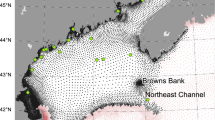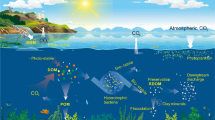Abstract
Export fluxes of particulate organic carbon (POC) were estimated from the 234Th/238U disequilibrium in the Ulleung Basin1 (UB) of the East/Japan Sea1 (EJS) over four seasons. The fluxes were calculated by multiplying the average POC/234Th ratio of sinking particles larger than 0.7 μm at 100- and 200-m water depths to 234Th fluxes by the integrated 234Th/238U disequilibrium from the surface to 100-m water depth. In spring, the 234Th profiles changed dramatically with sampling time, and hence a non-steady-state 234Th model was used to estimate the 234Th fluxes. The 234Th flux estimated from the non-steady-state model was an order of magnitude higher than that estimated from the steady-state model. The 234Th fluxes estimated using the steady-state model showed distinct seasonal variation, with high values in summer and winter and low values in autumn. In spring, the phytoplankton biomass had the highest value, and primary production was higher than in summer and autumn, but the 234Th fluxes were moderate. However, these values might have been significantly underestimated, as the 234Th fluxes were estimated using the steady-state model. The POC export fluxes estimated in autumn were about four times lower than those in other seasons when they were rather similar. The annually averaged POC flux was estimated to be 161 ± 76 mgC m−2 day−1, which was somewhat lower than that in highly productive coastal areas, and higher than that in oligotrophic regions. The export/primary production (ThE) ratios ranged from 7.0 to 56.1%, with higher values in spring and summer and lower values in autumn and winter. In summer, a high ThE ratio of 48.4 ± 7.0% was measured. This may be attributed to the mass diatom sinking event following nitrate depletion. In the UB1, the annually averaged ThE ratio was estimated to be 34.4 ± 12.9%, much higher than that in oligotrophic oceans. The high ThE ratio may have contributed to the high organic carbon accumulation in the UB1.





Similar content being viewed by others
Notes
The Editor-in-Chief recommends the usage of term “Tsushima Basin” in place of “Ulleung Basin”, and “Sea of Japan” or “Japan Sea” in place of “East Sea” , “East/Japan Sea” or “Japan/East Sea”.
The Editor-in-Chief recommends the usage of term “Takeshima” in place of “Dok island”.
References
Amiel D, Cochran JK, Hirschberg DJ (2002) 234Th/238U disequilibrium as an indicator of the seasonal export flux of particulate organic carbon in the North Water. Deep-Sea Res II 49:5191–5209
Babin M, Morel A, Gagmon R (1994) An incubator designed for extensive and sensitive measurements of phytoplankton photosynthetic parameters. Limnol Oceanogr 39:694–702
Bacon MP, Cochran JK, Hirschberg D, Hammer TR, Fleer AP (1996) Export flux of carbon at the equator during the EqPac time-series cruises estimated from 234Th measurements. Deep-Sea Res II 43:1133–1153
Benitez-Nelson C, Buesseler KO, Crossin G (2000) Upper ocean carbon export, horizontal transport, and vertical eddy diffusivity in the southwestern Gulf of Maine. Cont Shelf Res 20:707–736
Benitez-Nelson C, Buesseler KO, Karl D, Andrews JA (2001) A time-series study of particular matter export in the North Pacific subtropical gyre based upon 234Th/238U disequilibrium. Deep-Sea Res I 48:2595–2611
Böning P, Brumsack HJ, Böttcher ME, Schnetger B, Kriete C, Kallmeyer J, Borchers SL (2004) Geochemistry of Peruvian near-surface sediments. Geochim Cosmochim Acta 68:429–4451
Buesseler KO (1998) The decoupling of production and particulate export in the surface ocean. Global Biogeochem Cycles 12:297–310
Buesseler KO, Bacon MP, Cochran JK, Livingston HD (1992) Carbon and nitrogen export during the JGOFS north Atlantic Bloom experiment estimated from 234Th/238U disequilibria. Deep-Sea Res 39:1115–1137
Buesseler KO, Andrews JA, Hartman MC, Belastock R, Chai F (1995) Regional estimates of the export flux of particulate organic carbon derived from thorium-234 during the JGOFS EqPac program. Deep-Sea Res II 42:777–804
Buesseler KO, Steinberg DK, Michaels AF, Johnson RJ, Andrews JA, Valdes JR, Price JF (2000) A comparison of the quantity and composition of material caught in a neutrally buoyant versus surface-tethered sediment trap. Deep-Sea Res I 47:277–294
Buesseler KO, Benitez-Nelson C, Rutgers van der Loeff M, Andrews J, Ball L, Crossin G, Charette MA (2001) An intercomparison of small- and large-volume techniques for thorium-234 in seawater. Mar Chem 74:15–28
Buesseler KO, Benitez-Nelson C, Moran SB, Burd A, Charette MA, Cochran JK, Coppola L, Fisher NS, Fowler SW, Gardner WD, Guo LD, Gustafsson O, Lamborg C, Masque P, Miquel JC, Passow U, Santschi PH, Savoye N, Stewart G, Trull T (2006) An assessment of particulate organic carbon to thorium-234 ratios in the ocean and their impact on the application of 234Th as a POC flux proxy. Mar Chem 100:213–233
Charette MA, Moran SB (1999) Rates of particle scavenging and particulate organic carbon export estimated using 234Th as a tracer in the subtropical and equatorial Atlantic Ocean. Deep-Sea Res II 46:885–906
Cochran JK, Buesseler KO, Bacon MP, Wang HW, Hirschberg DJ, Ball L, Andrews J, Crossin G, Fleer A (2000) Short-lived thorium isotopes (234Th, 238Th) as indicators of POC export and particle cycling in the Ross Sea, Southern Ocean. Deep-Sea Res II 47:3451–3490
Coppola L, Roy-Barman M, Wassmann P, Mulsow S, Jeandel C (2002) Calibration of sediment traps and particulate organic carbon export using 234Th in the Barents Sea. Mar Chem 80:11–26
Foster JM, Shimmield GB (2002) 234Th as a tracer of particle flux and POC export in the northern North Sea during a coccolithophore bloom. Deep-Sea Res II 49:2965–2977
Giuliani S, Radakovitch O, Frignani M, Bellucci LG (2007) Short time scale variations of 234Th/238U disequilibrium related to mesoscale variability on the continental slope of the Gulf of Lions (France). Mar Chem 106:403–418
Gustafsson O, Buesseler KO, Geyer WR, Moran SB, Gschwend PM (1998) An assessment of the relative importance of horizontal and vertical transport of particle-reactive chemicals in the coastal ocean. Cont Shelf Res 18:805–829
Gustafsson O, Andersson P, Roos P, Kukulska Z, Broman D, Larsson U, Hajdu S, Ingri J (2004) Evaluation of the collection efficiency of upper ocean sub-photic-layer sediment traps: a 24-month in situ calibration in the open Baltic Sea using 234Th. Limnol Oceanogr Method 2:62–74
Hahm D, Kim K-R (2001) An estimation of the new production in the southern East Sea using helium isotopes. J Korean Soc Oceanogr 36:19–26
Hahm D, Kim K-R (2008) Observation of bottom water renewal and export production in the Japan Basin, East Sea using tritium and helium isotopes. Ocean Sci J 43:39–48
Hay BJ (1988) Sediment accumulation in the central western Black Sea over the past 5100 years. Paleoceanography 3:491–508
Hong G-I, Kim Y, Baskaran M, Kim S-H, Chung C-S (2008) Distribution of 210Po and export of organic carbon from the euphotic zone in the southwestern East Sea (Sea of Japan). J Oceanogr 64:277–292
Hung C-C, Gong G-C (2007) Export flux of POC in the main stream of the Kuroshio. Geophys Res Lett 34:L18606
Hyun J-H, Kim D, Shin C-W, Noh J-H, Yang E-J, Mok J-S, Kim S-H, Kim H-C, Yoo S (2009) Enhanced phytoplankton and bacterioplankton production coupled to coastal upwelling and an anticyclonic eddy in the Ulleung Basin, East Sea. Aquat Microb Ecol 54:45–54
Kang D-J, Kim J-Y, Lee T, Kim K-R (2004) Will the East/Japan Sea become an anoxic in the next century? Mar Chem 91:77–84
Kattner G (1999) Storage of dissolved inorganic nutrients in seawater: poisoning with mercuric chloride. Mar Chem 67:61–66
Kim K-R, Kim K, Kang D-J, Park SY, Park M-K, Kim Y-G, Min HS, Min D (1999) The East Sea (Japan Sea) in change: a story of dissolved oxygen. Mar Technol Soc J 33:15–22
Kim K, Kim K-R, Min D-H, Volkov Y, Yoon J-H, Takematsu M (2001) Warming and structural changes in the East (Japan) Sea: a clue to future changes in global oceans? Geophys Res Lett 28:3293–3296
KORDI (2003) Marine ecosystem responses to climate variability in the East Sea. Seoul, KORDI technical report, BSPE 825-00-1495-3
Lee T, Hyun JH, Mok JS, Kim D (2008) Organic carbon accumulation and sulfate reduction rates in slope and basin sediments of the Ulleung Basin, East/Japan Sea. Geo-Mar Lett 28:153–159
Maiti K, Benitez-Nelson C, Rii Y, Bidigare R (2008) The influence of a mature cyclonic eddy on particle export in the lee of Hawaii. Deep-Sea Res II 55:1445–1460
Masuda A (2000) Toward the clarification of variabilities in atmospheric and oceanic conditions in the Japan Sea. In: Proceedings of 49th conference of applied mechanics, pp 285–288
Moon D-S, Kim KH, Noh I (2000) The vertical fluxes of particles and radionuclides in the East Sea. J Korean Soc Oceanogr 35:16–33
Moran SB, Weinstein SE, Edmonds HN, Smith JN, Kelly RP, Pilson ME, Harrison WG (2003) Does 234Th/238U disequilibrium provide an accurate record of the export flux of particulate organic carbon from the upper ocean? Limnol Oceanogr 48:1018–1029
Savoye N, Benitez-Nelson C, Burd AB, Cochran JK, Charette M, Buesseler KO, Jackson GA, Roy-Barman M, Schmidt S, Elskens M (2006) 234Th sorption and export models in the water column: a review. Mar Chem 100:234–249
Schmidt S, Anderson V, Belviso A, Marty J-C (2002) Strong seasonality in particle dynamics of north-western Mediterranean surface waters as revealed by 234Th/238U. Deep-Sea Res I 49:1507–1518
Strickland JDH, Parsons TR (eds) (1972) A practical handbook of seawater analysis, 2nd edn. Fisheries Research Board of Canada, Bulletin No. 167
Thomalla S, Turnewitsch R, Lucas M, Poulton A (2006) Particulate organic carbon export from the North and South Atlantic gyres: the 234Th/238U disequilibrium approach. Deep-Sea Res II 53:1629–1648
Waples JT, Benitez-Nelson CR, Savoye N, Rutgers van der Loeff M, Baskaran M, Gustafsson O (2006) An introduction to the application and future use of 234Th in aquatic systems. Mar Chem 100:166–189
Yamada K, Ishizaka J, Yoo S, Kim H-C, Chiba S (2004) Seasonal and interannual variability of sea surface chlorophyll a concentration in the Japan/East Sea (JES). Prog Oceanogr 61:193–211
Yamada K, Ishizaka J, Nagata H (2005) Spatial and temporal variability of satellite primary production in the Japan Sea from 1998 to 2002. J Oceanogr 61:857–869
Yoo S, Kim H-C (2004) Suppression and enhancement of the spring bloom in the southwestern East/Japan Sea. Deep-Sea Res II 51:1093–1111
Yoo S, Park J (2009) Why is the southwest the most productive region of the East Sea/Sea of Japan? J Mar Syst 78:301–315
Acknowledgments
This work was primarily supported by an endowment project of the Korea Ocean Research and Development Institute (PE98563 & PE98564). We are indebted to the captain and crew of the R/V “Eardo”, who were very helpful with all our shipboard operations.
Author information
Authors and Affiliations
Corresponding author
Rights and permissions
About this article
Cite this article
Kim, D., Choi, MS., Oh, HY. et al. Seasonal export fluxes of particulate organic carbon from 234Th/238U disequilibrium measurements in the Ulleung Basin1 (Tsushima Basin) of the East Sea1 (Sea of Japan). J Oceanogr 67, 577–588 (2011). https://doi.org/10.1007/s10872-011-0058-8
Received:
Revised:
Accepted:
Published:
Issue Date:
DOI: https://doi.org/10.1007/s10872-011-0058-8




